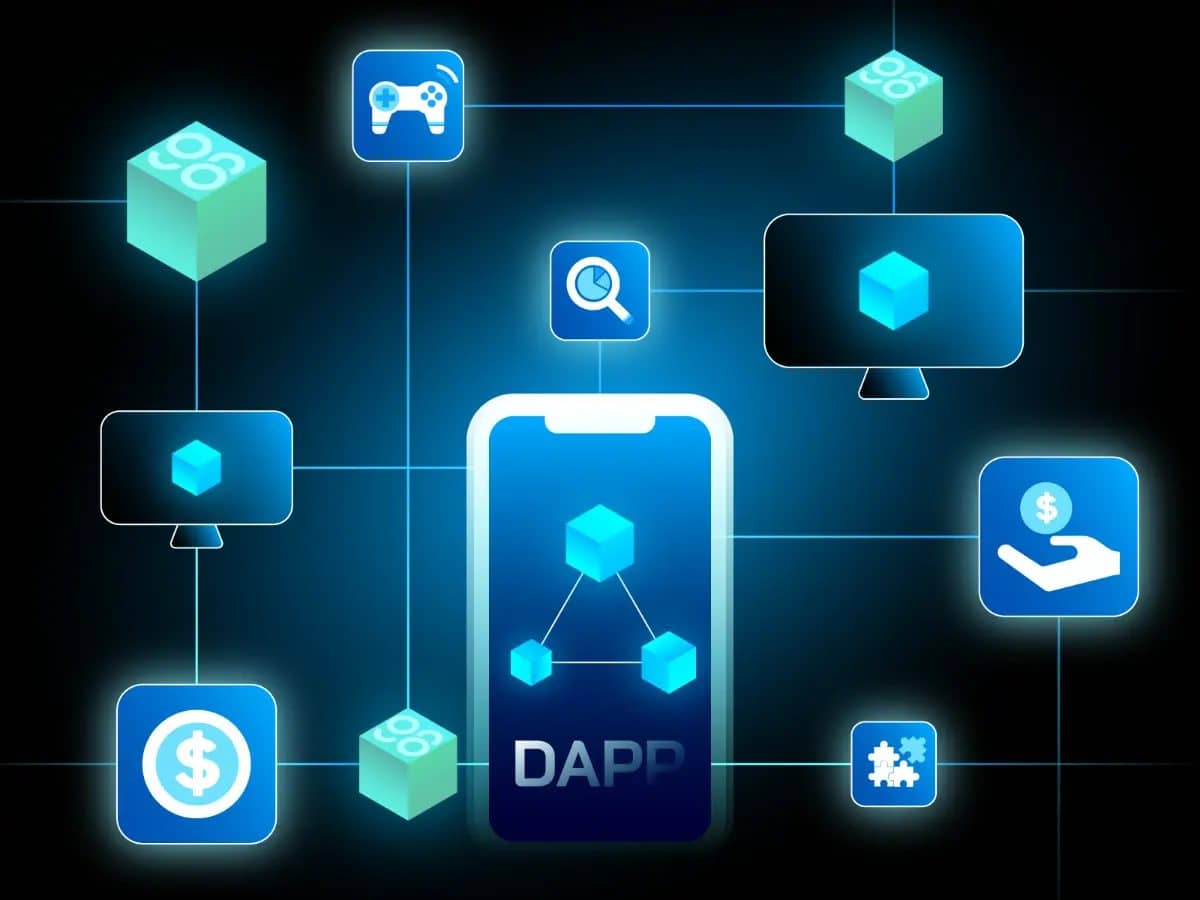
What is a dApp in crypto?
Decentralized applications, or dApps for short, have initiated a transformative revolution within the realms of cryptocurrency and blockchain technology. These innovative creations signify a monumental shift in our approach to digital platforms and services, presenting a novel paradigm characterized by decentralization and transparency. As we embark on this extensive guide, our mission is to embark on an in-depth exploration of the multifaceted concept of dApps within the domain of cryptocurrency.
We will not only unravel the essence of what dApps truly are but also delve into the intricate mechanisms governing their operation, scrutinize the manifold benefits they offer, dissect the formidable challenges they encounter, and evaluate the profound impact they exert upon the ever-expansive and dynamic crypto ecosystem.
What is a dApp?
In the realm of blockchain and cryptocurrency, a decentralized application, affectionately known as a dApp, signifies a distinct breed of software application. This innovative software operates within the intricate framework of a decentralized network, often leveraging blockchain technology. Diverging sharply from their conventional counterparts, dApps liberate themselves from the dominion of a singular entity or central authority. Instead, they gracefully navigate the digital landscape via a peer-to-peer network of interconnected computers, endowing them with the unique attributes of transparency, security, and censorship resistance.
To merit the illustrious classification of a dApp, an application must meet an array of specific criteria. These encompass pivotal facets such as open-source code, which ensures the accessibility of the application's underlying programming logic, and decentralized consensus mechanisms that underpin the decision-making processes within the dApp's operation. It is this amalgamation of features that characterizes dApps as a disruptive force within the technology landscape, heralding a future where decentralization and empowerment reign supreme.
How Do dApps Work?
Delving into the core of dApps, we uncover the foundational technology that propels their functionality – blockchain. These decentralized applications are intricately intertwined with blockchain technology, utilizing it as the backbone of their operations. One of the key elements at play within dApps is the ingenious concept of smart contracts, which fundamentally transforms the way agreements are executed.
Smart contracts can be visualized as self-executing agreements where the terms and conditions are directly embedded into code. This innovative approach empowers dApps to autonomously automate various processes and carry out actions without relying on intermediaries or central authorities. The beauty of this decentralized architecture lies in its ability to ensure transparency, security, and tamper-proof operations.
In essence, every transaction and operation carried out within a dApp is recorded on the blockchain, creating an indelible and immutable digital ledger. This cryptographic ledger serves as an incorruptible record of all interactions, reinforcing the trustworthiness and integrity of dApps. It is this intricate fusion of blockchain and smart contracts that bestows upon dApps their distinctive ability to operate autonomously, transparently, and securely, reshaping the landscape of digital applications.
Types of dApps
Within the expansive realm of decentralized applications, dApps exhibit a captivating diversity, often classified into three primary categories:
Type I (Blockchain-based dApps)
These dApps stand as autonomous entities with their dedicated blockchains. A stellar example of this category is Ethereum, complete with its native cryptocurrency, Ether. Ethereum has served as a pioneering platform, hosting a multitude of dApps that operate independently on its blockchain. Among them, Ethereum-based decentralized exchanges and decentralized finance (DeFi) protocols exemplify the innovative power of Type I dApps.
Type II (Protocol dApps)
Type II dApps are a unique breed, as they operate symbiotically with a Type I dApp's blockchain infrastructure. These dApps build their foundation on top of existing blockchain platforms, utilizing the native cryptocurrency for transactions and interactions. An illustrative instance is the OmiseGo project, which thrives on the Ethereum blockchain, enhancing scalability and utility while working in harmony with the Ethereum ecosystem. Type II dApps signify the collaborative spirit within the blockchain landscape.
Type III (Hybrid dApps)
Hybrid dApps represent the pinnacle of adaptability and versatility. They build upon the infrastructure of Type II dApps, embracing interoperability by connecting with multiple blockchains. Among these, Cosmos shines as an eminent example, facilitating interactions across diverse blockchain networks. The emergence of Type III dApps reflects a dynamic ecosystem, enabling users to navigate a multitude of blockchain environments seamlessly.
Each of these dApp categories unveils a unique facet of the decentralized application landscape, showcasing the ingenuity and innovation inherent in this transformative technology. As the dApp ecosystem continues to evolve, these classifications serve as a testament to the diverse possibilities and opportunities that await within the world of blockchain and decentralized applications.
Advantages of dApps
Decentralized applications, or dApps, usher in a myriad of benefits that redefine our digital landscape and empower users in unprecedented ways:
- Decentralization:
One of the foremost advantages of dApps lies in their decentralized nature. These applications operate without the centralized control of a single entity, drastically mitigating the risks associated with censorship, fraud, or unexpected downtime. Users can rest assured that their interactions within the dApp ecosystem are not beholden to the whims of a central authority, fostering a sense of autonomy and security.
- Transparency:
Transparency is an inherent quality of dApps, owing to their reliance on blockchain technology. Every transaction and operation executed within a dApp is meticulously recorded on the blockchain, forging an indelible and transparent ledger. This transparency empowers users to verify the authenticity of transactions and operations, eradicating doubts and instilling trust within the ecosystem.
- Security:
The robust security infrastructure of dApps is built upon the foundation of smart contracts and cryptographic techniques. These self-executing smart contracts enforce the terms of agreements with precision and without room for manipulation, drastically reducing the risks of hacking and fraudulent activities. In the world of dApps, security is not a mere afterthought but an inherent feature.
- Censorship Resistance:
One of the most compelling attributes of dApps is their resilience against censorship attempts. Operating on decentralized networks, these applications are impervious to centralized authorities' efforts to suppress or manipulate their functions. This censorship resistance empowers users to freely engage with dApps, secure in the knowledge that their activities remain untrammeled.
- Trustlessness:
In the realm of dApps, the need to place trust in a centralized authority is rendered obsolete. Users rely on code and blockchain consensus mechanisms to execute transactions and validate operations. This trustlessness fosters a sense of self-reliance and autonomy, liberating users from the traditional paradigm of trusting intermediaries.
- Tokenization:
Many dApps embrace the concept of tokens, which serve as versatile digital assets within their ecosystems. These tokens facilitate innovative economic models and enable participation in network governance. dApps have democratized access to participation in governance decisions and the economic structures underpinning their platforms, granting users a tangible stake in the ecosystem's development.
These myriad advantages collectively paint a vivid picture of the transformative potential of dApps. As they continue to proliferate and mature, dApps are poised to reshape industries, empower individuals, and redefine the very fabric of our digital interactions. In the world of dApps, the future holds boundless possibilities for those eager to explore the decentralized frontier.
Challenges and Limitations
While dApps offer a promising frontier in the world of blockchain and decentralization, they are not without their fair share of challenges and limitations:
- Scalability:
One of the most pressing challenges faced by dApps, particularly those built on the Ethereum blockchain, is scalability. The surge in usage has exposed limitations in transaction processing times and scalability, leading to congestion and high transaction fees. Scalability solutions, like Ethereum 2.0, are being developed to address this issue, but it remains a hurdle.
- User Experience:
The user interfaces of many dApps often cater to a technically proficient audience. This can present a steep learning curve for non-technical users, deterring wider adoption. Improving the user experience and making dApps more intuitive and accessible is an ongoing challenge.
- Regulatory Uncertainty:
The regulatory landscape for dApps is still in its infancy and varies significantly from one jurisdiction to another. This uncertainty can create challenges for dApp developers and users, as they may inadvertently run afoul of evolving regulations. Clearer regulatory guidance is needed to navigate this complex terrain.
- Interoperability:
Interoperability, or the ability of dApps to seamlessly interact with other dApps and blockchains, remains a technical challenge. Different blockchains and dApp ecosystems have distinct protocols and standards, making cross-chain interactions complex. Bridging these gaps to create a cohesive decentralized ecosystem is an ongoing effort.
The Impact of dApps on the Crypto Ecosystem
The influence of dApps within the cryptocurrency ecosystem is profound, catalyzing innovation and transformation across various domains:
Decentralized Finance (DeFi):
Within the crypto space, dApps have revolutionized decentralized finance (DeFi), ushering in a new era of financial inclusivity. These applications provide users with access to a wide array of financial services, including lending, borrowing, trading, and yield farming, all without the need for traditional financial intermediaries. DeFi dApps have democratized finance, making it accessible to a global audience, often without the constraints of identification or credit checks.
Non-Fungible Tokens (NFTs):
dApps have been instrumental in the meteoric rise of non-fungible tokens (NFTs). These unique digital assets have disrupted industries such as art, gaming, and entertainment, allowing creators to tokenize and sell their work directly to a global audience. NFT marketplaces powered by dApps have emerged as thriving hubs for digital collectibles and unique digital experiences.
Decentralized Exchanges (DEXs):
The advent of decentralized exchanges, enabled by dApps, has reshaped the traditional exchange landscape. DEXs empower users to trade cryptocurrencies directly from their wallets, eliminating the need for centralized intermediaries and custodial services. These platforms have gained prominence for their enhanced security and privacy features.
Innovative Fundraising Mechanisms:
dApps have introduced innovative fundraising mechanisms, notably Initial Coin Offerings (ICOs) and Initial DEX Offerings (IDOs). These fundraising methods allow projects to secure capital directly from the community, bypassing traditional venture capital channels. This democratizes investment opportunities and empowers small investors to participate in groundbreaking projects.
User Empowerment:
A fundamental impact of dApps is the empowerment of individual users. By leveraging dApps, individuals gain unprecedented control over their digital assets and transactions. This reduces reliance on centralized intermediaries, such as banks and payment processors, enabling users to engage in financial activities, access services, and partake in governance decisions with autonomy.
Conclusion
In the grand tapestry of cryptocurrency and blockchain technology, dApps stand as a revolutionary force, ushering in a profound evolution:
These remarkable applications bestow upon us an array of advantages, redefining the very essence of digital interactions. Decentralization, transparency, security, and trustlessness are their hallmarks, elevating the user experience to unprecedented levels of empowerment. However, it is not without its trials:
Challenges such as scalability, user experience, and the ever-evolving landscape of regulatory compliance await as hurdles to surmount. Yet, these challenges are the crucibles in which innovation thrives and progress takes root.
As the cryptocurrency ecosystem continues its relentless evolution, dApps will occupy a central stage, molding industries, and offering individuals newfound control and financial autonomy. To embark on this exhilarating journey into the transformative realm of cryptocurrency, understanding the concept and potential of dApps is an essential compass, guiding us toward a future defined by empowerment, innovation, and boundless possibilities.



